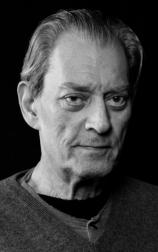Sunset Park
Review
Sunset Park
Readers accustomed to Paul Auster’s complex narrative puzzles in novels like ORACLE NIGHT and MAN IN THE DARK will need to put aside their preconceptions when they pick up his latest work, a quiet, deceptively simple exploration of the lives of a small group of damaged souls, “hanging on by a thread,” as Auster described them in a recent interview.
When we meet Miles Heller in 2008, he’s at Ground Zero of the mortgage crisis, working on a crew “trashing out” houses in south Florida on behalf of banks eager to remove any vestiges of the former owners’ lives and prepare the repossessed dwellings for resale. But 28-year-old Miles is no ordinary day laborer. He has dropped out of Brown University a year short of obtaining his degree and is in the midst of a seven-year odyssey traversing the United States, haunted by guilt over his role in a tragic incident as a teenager --- the death of his stepbrother in an automobile accident --- that left him “half a person,” someone whose “life has been sundered and will never be fully repaired.”
Miles needs a hiding place after the sister of Pilar Sanchez (the bright, ambitious 17-year-old girl he’s fallen in love with after they meet in a park where both are reading THE GREAT GATSBY) threatens to report their relationship to the authorities unless he delivers to her pieces of abandoned treasure from the houses he’s been emptying. He travels to New York to take up residence in an abandoned house where his childhood friend Bing Nathan and two young women have been living as squatters for four months. “Just another roll of the dice,” he muses, “another lottery pick scooped out of the black metal urn, another fluke in a world of flukes and endless mayhem.”
The house, “merely a shack, a forlorn piece of architectural stupidity that would not fit in anywhere, neither in New York nor out of it,” is located in Brooklyn’s Sunset Park neighborhood, across the street from Green-Wood Cemetery, the final resting place of famous New York luminaries like Leonard Bernstein, Horace Greeley and William Marcy “Boss” Tweed. Miles wanders through the graveyard, photographing the tombs as he had the detritus of the abandoned Florida dwellings.
Good-natured, benevolently anarchistic Bing has created the Hospital for Broken Things, “a hole-in-the-wall storefront enterprise devoted to repairing objects from an era that has all but vanished from the face of the earth: manual typewriters, fountain pens, mechanical watches, vacuum-tube radios, record players, wind-up toys, gumball machines, and rotary telephones.” When he’s not there he plays drums in the band Mob Rule, known for what he likes to think of as its “shit-kicking funk,” all the while tracking Miles’s erratic path through the years.
Alice Bergstrom, one of the female occupants of the house, is a Midwesterner writing her Ph.D. thesis on post-World War II America. She's obsessed with William Wyler’s 1946 movie The Best Years of Our Lives, “the national epic of that particular moment in American history --- the story of three men broken by war and the difficulties they confront when they return to their families,” and that film becomes a recurring motif of the novel. Aspiring artist Ellen Brice, a lonely, fragile young woman ill-suited to her day job as a real estate agent, is the fourth squatter.
Connected to this core group of characters, all in their late 20s, and yet each held back in some way from fully-realized adulthood, are Miles’s parents. Father Morris owns a foundering independent publishing house and imagines writing a memoir entitled Forty Years in the Desert: Publishing Literature in a Country Where People Hate Books. Miles’s mother and Morris’s ex-wife, Mary-Lee Swann, is an actress who has returned to the New York stage to star in a production of Samuel Beckett’s ironically titled Happy Days. And Morris’s wife Willa, the mother of Miles’s stepbrother, has never forgiven him for the loss of their son.
Separation, reunion, isolation and connection are all themes explored through Auster’s deep engagement in the lives of these characters as he peppers the novel with a handful of Austerian preoccupations --- baseball, the role of chance in our lives, the decline of literary culture. Writing in a clean, unaffected style, he captures the sense of dislocation and impermanence afflicting those who in a different era might have been comfortably situated amongst our social and cultural elites. Their angst is symbolized in the austere conditions at the Sunset Park house, and yet out of those grim surroundings the four inhabitants create an improvised family, each providing a measure of support, encouragement and understanding to the others.
But when the first eviction notice arrives and is ignored, followed in short order by several more, there’s a sense of foreboding that descends on the story, until at the novel’s end Miles “wonders if it is worth hoping for a future when there is no future.” Bleak as that observation may be, we cling to a slender reed of hope for these characters, as we must for ourselves. Isn't that what it means, in the end, to be human?
Reviewed by Harvey Freedenberg on October 12, 2011
Sunset Park
- Publication Date: October 26, 2011
- Genres: Fiction
- Paperback: 320 pages
- Publisher: Picador
- ISBN-10: 031261067X
- ISBN-13: 9780312610678




